Occupational environment monitoring of stationery manufacturing factory
99,000 ₫
Note: The above price is calculated for one sample, prices may fluctuate depending on the area of the environment to be monitored and market movements. For more accurate price support, please refer to the price list or contact our consulting staff directly.
Monitoring the environment of a stationery manufacturing factory is a session of collecting, analyzing, and evaluating factors at the workplace that may be harmful to workers’ health.
Table of Contents
Toggle1. Overview of Stationery Manufacturing Factories
a. What is a stationery manufacturing factory?
A stationery manufacturing factory is a specialized production facility that focuses on manufacturing products and tools used in office environments. This factory mainly produces items such as ballpoint pens, gel pens, pencils, erasers, adhesive tapes, glue, paper, notebooks, files, document folders, paper clips, stationery cases, and many other products.
In a stationery manufacturing factory, the typical production process includes processing raw materials, fabricating and assembling products, quality inspection, and packaging to prepare them for shipment and distribution to stores and dealers.
Stationery manufacturing factories usually use specialized machinery and equipment to carry out the production stages, including presses, cutters, printing machines, binding machines, cover machines, packaging machines, and quality inspection equipment. Advanced technology and production processes are applied to ensure high quality and optimal production efficiency.
Stationery manufacturing factories play an important role in supplying office products and tools to companies, organizations, schools, and individuals.

b. Production stages in a stationery manufacturing factory
The production stages in a stationery manufacturing factory may include the following:
- Raw material preparation: The factory collects and prepares the necessary raw materials for production. This includes purchasing, quality inspection, and storing materials such as ink, rubber, paper, plastic compounds, and other materials.
- Processing and fabrication: During this stage, raw materials are processed and fabricated into finished stationery products. Machinery and equipment are used to produce items such as pens, adhesive tapes, glue, paper, and other products. Processes include cutting, pressing, shaping, packaging, and other fabrication activities.
- Printing and decoration: If applicable, this stage includes printing and decorating stationery products such as pens, paper, files, and notebooks. Special printing machines are used to apply images, charts, logos, and other designs onto the products.
- Quality inspection: Before packaging and shipment, stationery products must undergo quality inspection. This ensures that the products meet quality standards and are free of defects. Inspections may include visual checks, functional tests, and packaging verification.
- Packaging and shipment: After products pass inspection, they are packaged according to specific procedures and standards. Packaging includes placing products in cartons, plastic bags, or other packaging, and attaching labels, tags, and instructions. The products are then prepared for shipment and distribution to dealers or stores.
- Inventory management: The factory needs to effectively manage inventory to ensure sufficient product quantities and meet market demand. Inventory management systems and periodic stock checks are implemented to maintain and accurately control stock levels.

c. Types of machinery used in a stationery manufacturing factory
In a stationery manufacturing factory, a variety of machinery and equipment are used for production stages. Some common machines in the stationery industry include:
- Plastic presses: Used to mold plastic products such as file covers, document folders, ring binders, and other plastic covers.
- Paper cutting machines: Used to cut paper into different sizes and shapes, such as A4, note paper, printing paper, and other office documents.
- Printing machines: Includes offset and digital printers to print stationery products such as pens, letterhead, printing paper, notebooks, and more.
- Book binding machines: Used to bind notebooks, files, and other spine-bound products.
- Cover binding machines: Used to attach covers to documents, files, and reports with materials like plastic, leather, cardboard, or soft covers.
- Packaging machines: Used to package and seal stationery products like pens, paper, adhesive tapes, and other goods.
- Label printing machines: Used to print labels and stickers for stationery products.
- Quality inspection machines: Includes dimension measurement machines, accuracy testers, durability testers, and other equipment to ensure product quality.
- Boxing machines: Used to pack products such as pens, erasers, paper, and other items before shipment.

d. Occupational diseases that may occur for workers in a stationery manufacturing factory
In a stationery manufacturing factory, workers may develop some occupational diseases. Some common occupational diseases include:
- Respiratory issues: Employees may be exposed to paper dust, ink dust, and chemicals during production, leading to respiratory problems such as pneumonia, asthma, and allergic reactions.
- Skin problems: Exposure to chemicals during production can cause skin issues like dermatitis, irritation, and other skin conditions.
- Eye problems: Workers may operate in bright lighting, and be exposed to chemicals and machinery, potentially causing eye irritation, pain, or strain.
- Hearing problems: Some work in the factory can produce high noise levels, e.g., from machines or packaging processes. Continuous exposure may lead to hearing loss or ear-related issues.
- Musculoskeletal and spinal issues: Repetitive tasks, heavy lifting, or prolonged standing can cause spinal problems, headaches, and back pain. Musculoskeletal issues such as joint degeneration and injuries may also occur.
To reduce the risk of occupational diseases, safety and health measures should be implemented in the stationery manufacturing factory. This includes ensuring proper ventilation, providing personal protective equipment, following safe work procedures, training employees on occupational safety, and maintaining industrial hygiene standards.

e. Common stationery products on the market
Some common stationery products you can find on the market include:
- Ballpoint pens: A widely used writing tool in offices and schools. Various types exist, including gel pens, water-based ink pens, and oil-based ink pens.
- Printing and photocopy paper: Paper used for printing and copying documents, available in various sizes and weights, including A4, letter, and legal sizes.
- Files and document folders: Used to organize and store documents, including hanging files, hard folders, pocket folders, and document organizers.
- Paper covers and bags: Used to protect and transport important documents, including plastic covers, leather covers, plastic bags, and paper bags.
- Adhesive tapes and glue: Used to bind documents and package boxes, including transparent tape, masking tape, glue sticks, and hot glue.
- Notebooks and books: Small books with pages for note-taking, recording, and drawing, available in various sizes and designs.
- Pen sets: Includes various writing tools such as ballpoint pens, fountain pens, water-based ink pens, pencils, and markers, often packaged as a complete set.
- Electronic files: Documents and information stored and managed on computers and electronic media, including text files, spreadsheets, images, and other documents.
- Stationery toys: Small products used for relaxation and entertainment in the office, including stress balls, mini games, and dice toys.
These are just some examples of popular stationery products; many others exist, such as colored pens, calculators, decorative stamps, mouse pads, markers, and document files.

2. Overview of Occupational Environmental Monitoring Services
a. What is occupational environmental monitoring in a stationery manufacturing factory?
Occupational environmental monitoring (or labor environment measurement) in a stationery manufacturing factory is the activity of collecting, assessing, and analyzing measurement indicators of occupational environment factors at the factory. The goal is to implement timely measures, minimize environmental hazards to workers’ health, and prevent occupational diseases. Occupational environmental monitoring is a mandatory requirement for stationery manufacturing factories.
Occupational environmental monitoring plays a crucial role in caring for, protecting, and enhancing workers’ health because the main resource of a company, which directly generates profit, is its workforce. Workers who are regularly exposed to hazards exceeding permissible limits may be affected health-wise and develop occupational diseases.
REGISTER FOR OCCUPATIONAL ENVIRONMENT MONITORING SERVICE
b. Nam Viet’s occupational environmental monitoring program
Nam Viet’s occupational environmental monitoring program is a program developed by monitoring engineers in the field of occupational safety and environmental protection. With the aim of ensuring workers’ health and safety, this program uses modern measurement methods to monitor air quality, water, microclimate factors, physical parameters, dust, and more in the workplace. It is crucial for ensuring a safe working environment and protecting workers’ health.
Additionally, Nam Viet’s program plays an important role in researching and developing new solutions to improve workplace environmental quality. With the dedication and professionalism of the monitoring experts, Nam Viet’s exclusive monitoring program has become a breakthrough in occupational safety and environmental management in Vietnam.

c. Standardization in occupational environment measurement procedures
Standardization in Nam Viet’s occupational environment measurement procedures is crucial for ensuring the quality of results. To ensure accuracy and reliability, the program uses standards and standardized procedures recognized by the Ho Chi Minh City Department of Health. This ensures that the collected data can be reliably used to assess the workplace environment and make decisions to improve it and protect workers’ health.
These standardized procedures also ensure that the measurements are conducted by highly skilled monitoring specialists with years of experience, allowing managers and experts to trust results from An Toàn Nam Viet and make accurate, valuable decisions in protecting workers’ health and the environment.
By applying standardization in occupational environment measurement, Nam Viet demonstrates its commitment to ensuring a safe working environment and protecting workers’ health, while contributing to the development and enhancement of occupational safety and environmental management in Vietnam.
d. Reporting results of environmental monitoring in stationery manufacturing factories
Environmental monitoring results are prepared according to Form No. 04, Appendix III issued with Decree 44/2016/ND-CP and are prepared in two copies: one copy sent to the workplace that contracted the monitoring service, and one copy retained by the monitoring organization.
The retention period for occupational environmental monitoring results is unlimited according to legal regulations.

e. Frequency of occupational environmental monitoring as per law
According to Clause 2 of Article 18, Law on Occupational Safety and Health 84/2015/QH13, employers must organize occupational environment monitoring to assess harmful factors at least once a year.
f. Deadline for submitting occupational environmental monitoring reports as per law
The deadline is before December 31 each year. Enterprises in mandatory production facilities must submit occupational environmental monitoring reports to the local Department of Health where the business is headquartered and where employees work.
Whenever there are changes in technology, production processes, or during renovations/upgrades that may generate new harmful factors affecting workers’ health, enterprises must update occupational hygiene records regarding the harmful factors that require monitoring.
g. Penalties for violations of occupational environmental monitoring by employers
According to Article 27 of Decree No. 12/2022/ND-CP dated January 17, 2022, on administrative penalties in labor, social insurance, and Vietnamese employees working abroad under contracts:
- Clause 2: Fines ranging from VND 2,000,000 – 5,000,000 for employers who do not publicly disclose monitoring results to workers at the workplace and to areas where hazardous factors are evaluated immediately after monitoring and evaluation results are available.
- Clause 3: Fines ranging from VND 20,000,000 – 40,000,000 for employers who fail to conduct occupational environmental monitoring to control health risks to workers as required by law.
- Clause 4: Fines ranging from VND 40,000,000 – 60,000,000 for employers who cooperate with monitoring organizations to commit fraud in environmental monitoring activities without reaching criminal liability.
3. Harmful Environmental Factors for Workers in Stationery Manufacturing Factories
In stationery manufacturing factories, there are several environmental factors that may be harmful to workers. Some potential environmental factors in this industry include:
- Dust: The production of stationery can generate dust from paper, ink, and other materials. Exposure to dust can cause eye, respiratory, and skin irritation.
- Chemicals: Stationery production requires the use of various chemicals such as inks, solvents, and cleaning agents. Long-term exposure to these chemicals can cause skin irritation, pneumonia, and other health issues.
- Lighting: Some tasks in stationery factories require working under strong or artificial light. Excessive exposure to light can cause eye strain, visual fatigue, and related vision problems.
- Noise: Machinery and equipment in stationery factories can produce significant noise. Continuous exposure to noise can damage hearing and cause insomnia, stress, and affect mental well-being.
- Temperature and humidity: Work environments with inappropriate temperature and humidity can cause discomfort and negatively affect workers’ health.
- Ergonomics: Poorly designed workstations and equipment can lead to muscle and skeletal strain, back pain, wrist pain, and other health issues related to improper work posture.
To reduce risks and protect workers’ health, stationery manufacturing factories should implement protective measures such as providing personal protective equipment and ensuring proper ventilation.
REGISTER FOR OCCUPATIONAL ENVIRONMENT MONITORING SERVICE
4. Measures to Improve the Work Environment in Stationery Manufacturing Factories
To improve the work environment in stationery factories and protect workers’ health, the following measures can be applied:
- Dust management: Ensure industrial hygiene and effective dust control during production. Use ventilation systems, dust extraction, and air filtration to minimize airborne dust and prevent it from spreading in the work environment.
- Chemical management: Apply safety measures for the use, storage, and handling of chemicals. Ensure workers are trained in safe usage, wear appropriate personal protective equipment, and comply with chemical safety regulations.
- Lighting improvement: Ensure appropriate natural and artificial lighting in the workspace. Adjust lighting to avoid glare and provide sufficient illumination without causing eye strain.
- Noise control: Implement measures to reduce noise in the work environment. Use soundproofing, reposition machinery, provide ear protection, and comply with occupational sound safety regulations.
- Temperature and humidity adjustment: Maintain comfortable temperature and humidity conditions. Use air conditioning systems and other methods to provide a comfortable work environment without negatively impacting workers’ health.
- Ergonomics: Ensure workstations and equipment are ergonomically designed and suitable for workers. Provide chairs and desks with supportive designs, appropriate height, positioning, and angles to reduce muscle and skeletal strain.
- Training and awareness: Train workers on occupational safety, proper use of personal protective equipment, chemical management, and other protective measures. Raise awareness about a safe work environment and relevant regulations to ensure compliance and implementation of safety policies and procedures.
- Regularly conduct occupational environment monitoring in factories to collect and analyze harmful factors affecting workers and adjust to reduce risks, thereby preventing occupational diseases.
5. Benefits of Regular Monitoring in Stationery Manufacturing Factories
An Toàn Nam Việt provides businesses with valuable benefits when using occupational environment monitoring services in accordance with Decree 44/2016/NĐ-CP on managing and controlling harmful factors in the work environment affecting employees.
- Businesses can proactively monitor harmful factors in their factories.
- Receive recommendations on measures to reduce harmful factors and improve work environment quality.
- Indirectly protect human resources, a key factor in business development.
- Minimize the impact of occupational diseases on workers’ health, reducing future treatment costs.
- Improved worker health leads to better product quality and ensures consistent production output.
- Comply with labor safety regulations, avoiding legal risks.
- Enhance credibility and professionalism in all aspects, boosting the company’s brand image.
Nam Viet’s environmental monitoring service is a solution to mitigate occupational disease risks, contributing to a clean and high-quality work environment.

6. Nationwide Occupational Environment Monitoring Center
Nam Viet Occupational Environment Monitoring Center is a professional unit specializing in monitoring and measuring workplace environmental quality throughout all provinces of Vietnam. With an experienced team of environmental monitoring specialists, the center uses modern measuring equipment to ensure accuracy and reliability.
In addition to providing monitoring services, the center supports clients in planning, handling, and following up on occupational environment issues. With the motto “customer-centered,” the center prioritizes client satisfaction, meets all client needs, and commits to providing the best solutions.
REGISTER FOR OCCUPATIONAL ENVIRONMENT MONITORING SERVICE
With investment in technology, equipment, and human resources, Nam Viet’s monitoring center has become a reputable unit in occupational environment monitoring in Ho Chi Minh City, with the following goals:
- Value brand reputation and service quality.
- Provide clients with the best and most suitable solutions.
- Work with experienced Masters and Engineers aiming to protect the environment and benefit businesses.
- Offer professional services by experts in environmental monitoring and provide cost-effective advantages.
The occupational environment monitoring process at Nam Viet includes the following basic steps:
- Before monitoring, ensure all equipment is calibrated and adjusted according to legal requirements.
- Carry out the monitoring process as committed to the Department of Health.
- Report accurate monitoring results to employers.
- If monitoring results indicate unsafe conditions for workers, Nam Viet will provide corrective solutions, and the factory will implement:
- Implement measures to improve working conditions, minimizing harmful factors and preventing occupational diseases.
- Organize medical check-ups to detect occupational and work-related illnesses for employees in unsafe environments.
- Provide compensation in kind for workers according to labor law regulations.

7. Occupational Environment Monitoring Price List
To help businesses conduct professional and effective occupational environment monitoring, Nam Viet provides clients with a detailed and reasonably priced service price list.
- Our price list provides detailed information on the costs of all monitoring services, including transportation, measurement, analysis, and reporting. Clients can be confident in the accuracy and reliability of the monitoring reports provided.
- We are committed to offering competitive and reasonable prices while providing prompt and professional consultation on any service-related inquiries.
- With Nam Viet’s price list, clients can easily select services that best meet their needs. We guarantee maximum satisfaction with professional service quality.
No comments yet

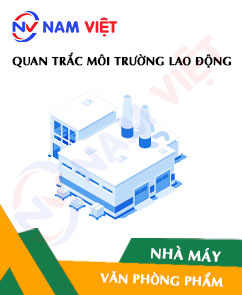
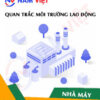
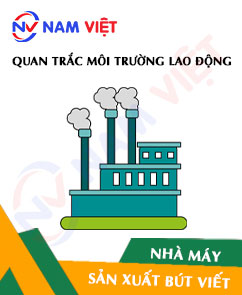




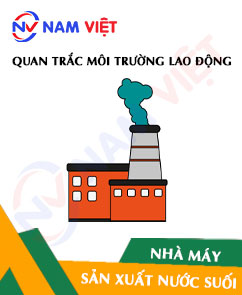
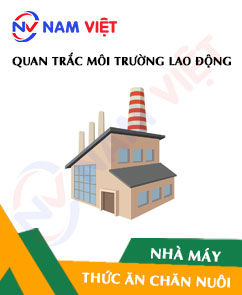

Review Occupational environment monitoring of stationery manufacturing factory
There are no reviews yet.